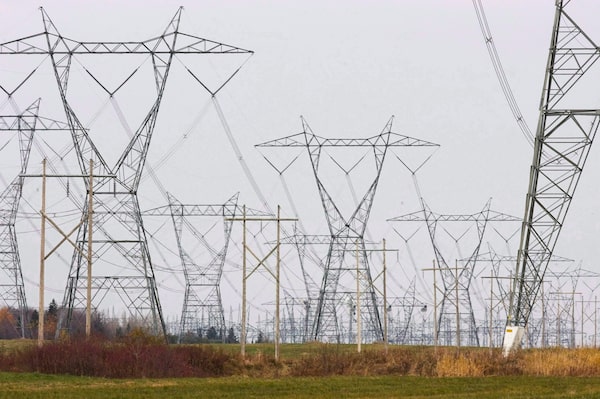
Hydro-Québec power lines in Lévis, Que.Jacques Boissinot/The Canadian Press
Hydro-Québec has begun early-stage talks with a number of financiers and other potential partners as it plans how to carry out a $185-billion strategy for new energy infrastructure that aims to wean Quebec off fossil fuels.
The utility, Canada’s biggest producer of hydroelectricity, will spend as much as $110-billion from now until 2035 on new clean-power generation facilities and another $50-billion to improve the reliability of its electrical grid under a plan unveiled last November. Additional operating expenses will make up the balance of the estimated spending.
The scope and ambition of the plan has attracted “a considerable amount of attention” in financial markets, chief executive Michael Sabia told reporters Wednesday on a conference call to discuss the utility’s annual results.
“We have had expressions of interest, on a whole variety of different things, from sources of finance for this program,” Mr. Sabia said, declining to name any firms his team is speaking with. “We’re quite optimistic about our capacity to find the capital we need to make this program happen.”
Mr. Sabia sees three big opportunities to boost electricity volumes in the near term. First, while hunting for new hydroelectric development sites, the company will upgrade the turbines on existing hydro facilities to crank out more power. Next, it will triple wind power generation. And third, it will use less of the power already being generated by encouraging customers to increase energy efficiency.
Hydro-Québec plans to produce more solar and battery power, and to launch a pumped-storage hydroelectric facility, which adds supply for use during peak demand periods. It’s also aiming to build 5,000 kilometres of new transmission lines. Over all, it will quicken the pace of capital investment to $16-billion per year, twice what was spent annually during the construction in the 1970s and 1980s of the James Bay hydropower stations.
The utility intends to keep tapping bond markets to finance part of the plan, Mr. Sabia said. It sold $3.7-billion worth of notes to investors last year, a period during which it faced a number of weather-related operational challenges.
Hydro-Québec on Wednesday reported net income of $3.3-billion for 2023 – a 28-per-cent decline from the record $4.56-billion the year before – as scant snow cover in late winter, lighter-than-usual spring runoff and warmer temperatures left it with lower water volumes in its hydropower reservoirs. The utility cut exports in response, earning $547-million less in sales from markets outside Quebec than the year before.
It was the lowest year for power exports, as measured by volume, in a decade. On the flip side, the utility used hedging strategies to obtain 10.3 cents per kwh for the power it exported over the period, nearly double the average market price. The company signs forward contracts extending about a year ahead, typically for as much as half its export volume. Such deals help shield it from price drops.
Mr. Sabia will need the co-operation of First Nations communities to execute his strategy because much of the planned infrastructure will likely cross their ancestral lands. The relationship between the utility and certain communities is heavily strained. To take just one example, the Innu of Labrador are suing the utility for $4-billion in damages from when their traditional territories were flooded to build reservoirs decades ago.
Mr. Sabia is vowing that First Nations and Inuit communities will be partners in clean-energy projects and be offered financial participation in them, not through one-time cash settlements but rather through steady income streams. He calls the approach “economic reconciliation.”
The Quebec government last week signed a framework agreement with one group, the Innu of Pessamit, that will see the province contribute $45-million to promote local development in the community. The agreement includes proposed solutions for the management of a hydropower water reservoir near the community as well as commitments related to wind power development, the government said in a statement.
“We’re working with several other communities and we hope to announce more progress over the coming months,” Mr. Sabia told reporters. “This year has the potential to be a turning point for putting our relations with First Nations communities on a new and better trajectory.”